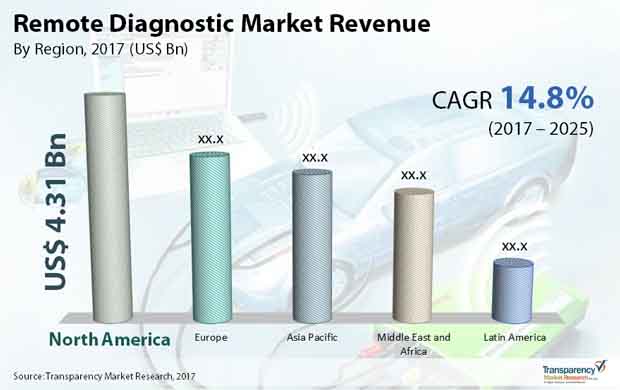
The global remote diagnostic market displays a highly competitive vendor landscape with numerous companies focusing on launching new products to strengthen their hold in the market, reports Transparency Market Research (TMR). The competition in this market is driven by new technological advancements and research-based activities.
Prominent players in the global remote diagnostic market comprise Continental AG, OnStar LLC, Robert Bosch GmbH, Mercedes-Benz, Delphi Automotive plc, Magneti Marelli S.p.A., Softing AG, and Vector Informatik GmbH. These companies are adopting various strategies such as collaborations to expand their revenue share in the market.
As per expert analysts, the global remote diagnostic market is expected to garner an astounding CAGR of 14.8% from 2017 to 2025. The market valued at US$12.88 bn in 2016 and is expected to reach a value of US$42.04 bn by 2025.
The remote diagnostic market is segmented based on roadside assistance, vehicle state alert, vehicle tracking, training assistance, and others. Roadside assistance segment is expected to lead the market in terms of revenue owing to rising demand for vehicle safety on road. Geographically, North America leads the market on account of stringent regulations for road safety.

Increase in Sales for Hybrid Vehicles to Spike the Market’s Growth
In recent times, consumer preference has shifted towards hybrid vehicles leading to a major surge in the global remote diagnostic market. Additionally, with recent technological advancements, there has been a rise in demand for in-vehicle diagnostic technology as it allows efficient management and diagnosis of data. This has played a key role in driving the growth of the global remote diagnostic market. Furthermore, rapid industrialization leading to a surge in the electrical industry has contributed to the market’s expansion.
For More Industry Insight, Request Sample@ https://www.transparencymarketresearch.com/sample/sample.php?flag=S&rep_id=19292
Moreover, emission standards laid down by several governments owing to growing environmental concerns have contributed to an expansion in the market. Degradation of air quality has posed alarming environmental threats leading to governments taking measures to control it. Additionally, a growing demand for premium cars and luxury vehicles has propelled the remote diagnostic market’s growth.
In addition to the aforementioned drivers, integration of Internet of Things (IoT) and telematics technology will lead to an increase in demand for remote diagnostic devices, thereby propelling the growth global remote diagnostic market. These technologies equip devices to notify the users of probable system failures and the preventive measures that need to be taken.
On the downside, there are a few bottlenecks that may thwart the remote diagnostic market’s growth. Factors such as security concerns associated with operating remote diagnostic systems may restrain the market’s growth. Nonetheless, companies are working on bridging the gaps between the original equipment manufacturer (OEM) and the end users. This will drastically change the consumers’ outlook towards remote diagnostic systems, thereby expediting global remote diagnostic market’s growth.
C2i Technology to Create New Avenues for the Market
Chromalox has developed a new C2i technology which is an amalgamation of several control technologies that improve system reliability. Additionally, it offers process optimization through remote diagnostics and monitors component health. This has served as a major landmark in the global remote diagnostic market.
Wearable ECG Monitor to Present New Opportunities
Nuubo’s electrocardiograph (ECG) monitor is a healthcare diagnostic device that facilitates an improved diagnostic yield of several heart arrhythmias such as atrial fibrillation. Additionally, it reduces per patient diagnosis costs and offers monitoring flexibility. Development of such technologies has attracted a lot of consumers, consequently helping the remote diagnostic market to grow its frontiers globally.





